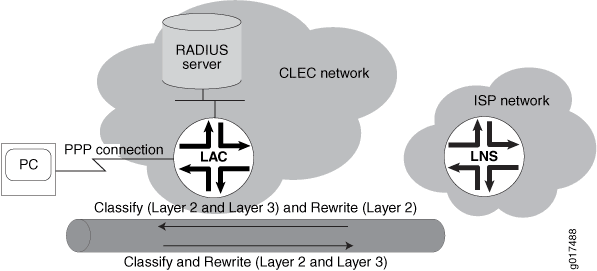CoS for L2TP LAC Subscriber Interfaces Overview
You can apply CoS to the Layer 2 Tunnel Protocol (L2TP) access concentrator (LAC) component.
In Layer 2 Tunnel Protocol (L2TP) configurations, IP and L2TP headers are added to packets arriving at a PPP subscriber interface on the L2TP access concentrator (LAC) before being tunneled to the L2TP network server (LNS). You can manage the IP header by configuring classifiers and rewrite-rules that transfer the ToS (Type of Service) value or the 802.1p value from the inner IP header to the outer IP header of the L2TP packet.
Figure 1 shows the classifier and rewrite rules that you can configure from the LAC to the LNS, and from the LNS to the LAC.

Traffic from LAC to LNS
To set the ToS value or the 802.1p value on the inner IP header, you can configure both fixed and behavior aggregate (BA) classifiers for subscribers at Layer 2 or Layer 3 of the network.
Table 1 lists the configuration options for applying classifiers to a subscriber interface on an ingress LAC tunnel.
|
Classifier |
Subscriber Interface |
|---|---|
|
Fixed |
Either of the following:
|
|
Layer 2 |
Either of the following:
|
|
Layer 3 |
Family of PPP interfaces |
You cannot configure a Layer 2 and fixed classifier together.
The behavior of the Layer 2 and Layer 3 classifiers depends on the configuration. For example, a Layer 3 classifier for a family of PPP interfaces overrides a Layer 2 classifier configured at the PPP interface, except for the unknown packets and control packets.
If you do not configure a classifier for Layer 2, the system applies the default Layer 3 classifier so that tunneled and terminated subscribers have the same behavior. To prevent unknown packets and control packets from being discarded, the system assigns them to the best-effort forwarding class.
For egress tunnels, you configure rewrite rules at the PPP interface to set the ToS or 802.1p value of the outer IP header. Rewrite rules are applied accordingly to the forwarding class, packet loss priority (PLP), and code point.
LAC Tunnels: Traffic from LNS to LAC
On a LAC, mapping the inner IP header to the outer IP header of the L2TP packet depends on the classifier and rewrite-rule configurations. For example, Table 2 lists the values for the classifier and rewrite rules for a VLAN interface. For assured forwarding, the inner 802.1p value (ob001) is classified with the assured-forwarding class and low loss priority at the ingress interface. Based on the assured-forwarding class and low loss priority in the rewrite rule, the ToS value in the outer IP header is set to ob001.
|
Inner .1p Value |
Forwarding Class |
Loss Priority |
Code Point |
Outer ToS Value |
|---|---|---|---|---|
|
ob000 |
best-effort |
low |
000 |
ob000 |
|
ob001 |
assured-forwarding |
low |
001 |
ob001 |
|
ob101 |
expedited-forwarding |
low |
101 |
ob101 |
|
ob111 |
network-control |
low |
11 |
ob111 |
